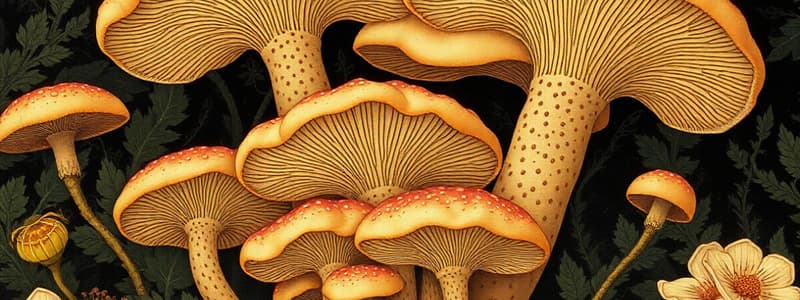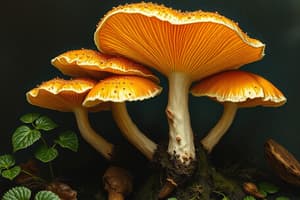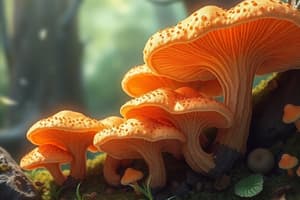Podcast
Questions and Answers
Which structure in fungi is responsible for the formation of spores?
Which structure in fungi is responsible for the formation of spores?
- Rhizoids
- Hyphae
- Mycelium
- Fruiting body (correct)
What type of organisms primarily compose the phylum Chytridiomycota?
What type of organisms primarily compose the phylum Chytridiomycota?
- Freshwater pathogens
- Soil mycorrhizal fungi
- Marine saprophytes (correct)
- Terrestrial saprophytes
What distinguishes Ascomycota from Zygomycota?
What distinguishes Ascomycota from Zygomycota?
- Most Ascomycota are multicellular. (correct)
- Ascomycota do not form spores.
- Most Ascomycota are unicellular.
- Ascomycota have flagellated spores.
During which stage of sexual reproduction does karyogamy occur?
During which stage of sexual reproduction does karyogamy occur?
What are the two types of hyphae found in the phylum Zygomycota?
What are the two types of hyphae found in the phylum Zygomycota?
Which process is NOT a typical method of fungal reproduction?
Which process is NOT a typical method of fungal reproduction?
Which of the following structures is a mass of hyphae?
Which of the following structures is a mass of hyphae?
In the generalized life cycle of fungi, which stage follows plasmogamy?
In the generalized life cycle of fungi, which stage follows plasmogamy?
What process follows plasmogamy in the life cycle of fungi?
What process follows plasmogamy in the life cycle of fungi?
Which type of reproduction involves a part of the mycelium separating and starting a new life?
Which type of reproduction involves a part of the mycelium separating and starting a new life?
In what condition do fungi typically engage in sexual reproduction?
In what condition do fungi typically engage in sexual reproduction?
What do the diploid chromosomes become after they are pulled apart in fungal reproduction?
What do the diploid chromosomes become after they are pulled apart in fungal reproduction?
What is the state of fungi that can grow as either mycelia or yeast depending on temperature?
What is the state of fungi that can grow as either mycelia or yeast depending on temperature?
Which statement accurately reflects the nature of fungi as decomposers?
Which statement accurately reflects the nature of fungi as decomposers?
What forms when fungi and algae come together?
What forms when fungi and algae come together?
What fungal reproductive process uses a small cell that pinches off as it grows?
What fungal reproductive process uses a small cell that pinches off as it grows?
What is a characteristic feature of the lysogenic cycle?
What is a characteristic feature of the lysogenic cycle?
Which of the following correctly describes viroids?
Which of the following correctly describes viroids?
How do prions replicate despite containing no nucleic acid?
How do prions replicate despite containing no nucleic acid?
What process do viruses use to enter animal cells?
What process do viruses use to enter animal cells?
Which statement about fungi is true?
Which statement about fungi is true?
What distinguishes prions from viruses and viroids?
What distinguishes prions from viruses and viroids?
Which of the following statements best describes how viruses enter bacterial cells?
Which of the following statements best describes how viruses enter bacterial cells?
Which of the following is a notable feature of the lysogenic cycle compared to the lytic cycle?
Which of the following is a notable feature of the lysogenic cycle compared to the lytic cycle?
What is the primary method by which fungi obtain energy?
What is the primary method by which fungi obtain energy?
Which of the following correctly describes the cell wall composition of fungi?
Which of the following correctly describes the cell wall composition of fungi?
Which statement about the reproductive structure of fungi is true?
Which statement about the reproductive structure of fungi is true?
Which characteristic is NOT typical of fungi?
Which characteristic is NOT typical of fungi?
What do the multicellular structures of fungi consist of?
What do the multicellular structures of fungi consist of?
Which of the following statements about fungal reproduction is accurate?
Which of the following statements about fungal reproduction is accurate?
How do many fungi interact with other organisms?
How do many fungi interact with other organisms?
What distinguishes yeast from other types of fungi?
What distinguishes yeast from other types of fungi?
What structural feature connects the head of a bacteriophage to the tail sheath?
What structural feature connects the head of a bacteriophage to the tail sheath?
Which step in the lytic cycle immediately follows the entry of the virus into the host cell?
Which step in the lytic cycle immediately follows the entry of the virus into the host cell?
How do viruses utilize the host cell in the reproduction process?
How do viruses utilize the host cell in the reproduction process?
What type of protein activity is found at the end plate of a bacteriophage?
What type of protein activity is found at the end plate of a bacteriophage?
In the lysogenic cycle, what happens to the viral DNA?
In the lysogenic cycle, what happens to the viral DNA?
What is the primary outcome of the lytic cycle for the host cell?
What is the primary outcome of the lytic cycle for the host cell?
What component of the bacteriophage is used to recognize receptor proteins on bacterial cells?
What component of the bacteriophage is used to recognize receptor proteins on bacterial cells?
What common characteristic defines viruses as parasites?
What common characteristic defines viruses as parasites?
What role do mycorrhizae play in the ecosystem?
What role do mycorrhizae play in the ecosystem?
How do lichens benefit from their relationship with their partners?
How do lichens benefit from their relationship with their partners?
Which of the following diseases is caused by a pathogenic fungus?
Which of the following diseases is caused by a pathogenic fungus?
What is the role of haustoria in parasitic fungi?
What is the role of haustoria in parasitic fungi?
Which group of fungi is often linked with food spoilage?
Which group of fungi is often linked with food spoilage?
What is a characteristic of pioneer species in fungal contexts?
What is a characteristic of pioneer species in fungal contexts?
Which characteristic is NOT associated with pathogenic fungi?
Which characteristic is NOT associated with pathogenic fungi?
What utility of fungi contributes to environmental cleanup?
What utility of fungi contributes to environmental cleanup?
Flashcards
Bacteriophages
Bacteriophages
A type of virus that infects bacteria. They consist of a head containing DNA surrounded by a protein coat, a tail sheath, and tail fibers.
Viral Reproduction
Viral Reproduction
The process by which a virus replicates inside a host cell.
Attachment (Lytic Cycle)
Attachment (Lytic Cycle)
The first stage of the lytic cycle, where the virus attaches itself to the surface of a host cell using its tail fibers.
Entry (Lytic Cycle)
Entry (Lytic Cycle)
Signup and view all the flashcards
Replication (Lytic Cycle)
Replication (Lytic Cycle)
Signup and view all the flashcards
Assembly (Lytic Cycle)
Assembly (Lytic Cycle)
Signup and view all the flashcards
Lysis/Release (Lytic Cycle)
Lysis/Release (Lytic Cycle)
Signup and view all the flashcards
Lysogenic Cycle
Lysogenic Cycle
Signup and view all the flashcards
How do fungi obtain nutrients?
How do fungi obtain nutrients?
Signup and view all the flashcards
What is extracellular digestion?
What is extracellular digestion?
Signup and view all the flashcards
What are hyphae?
What are hyphae?
Signup and view all the flashcards
What are spores?
What are spores?
Signup and view all the flashcards
What is the role of fungi in the ecosystem?
What is the role of fungi in the ecosystem?
Signup and view all the flashcards
What does it mean when fungi are symbionts?
What does it mean when fungi are symbionts?
Signup and view all the flashcards
What is the main component of fungal cell walls?
What is the main component of fungal cell walls?
Signup and view all the flashcards
Give some examples of common fungi.
Give some examples of common fungi.
Signup and view all the flashcards
What is the lysogenic cycle?
What is the lysogenic cycle?
Signup and view all the flashcards
How do viruses enter living cells?
How do viruses enter living cells?
Signup and view all the flashcards
What are viroids?
What are viroids?
Signup and view all the flashcards
What are prions?
What are prions?
Signup and view all the flashcards
How do prions replicate?
How do prions replicate?
Signup and view all the flashcards
What is the ecological importance of fungi?
What is the ecological importance of fungi?
Signup and view all the flashcards
What are some adaptations of fungi?
What are some adaptations of fungi?
Signup and view all the flashcards
What is a mycelium?
What is a mycelium?
Signup and view all the flashcards
What is a fruiting body?
What is a fruiting body?
Signup and view all the flashcards
What are cross-walls (septa) in fungi?
What are cross-walls (septa) in fungi?
Signup and view all the flashcards
What are chytrids (Chytridiomycota) ?
What are chytrids (Chytridiomycota) ?
Signup and view all the flashcards
What are zygomycetes (Zygomycota)?
What are zygomycetes (Zygomycota)?
Signup and view all the flashcards
What are ascomycetes (Ascomycota)?
What are ascomycetes (Ascomycota)?
Signup and view all the flashcards
What are basidiomycetes (Basidiomycota)?
What are basidiomycetes (Basidiomycota)?
Signup and view all the flashcards
What is plasmogamy?
What is plasmogamy?
Signup and view all the flashcards
What is karyogamy?
What is karyogamy?
Signup and view all the flashcards
What is fragmentation?
What is fragmentation?
Signup and view all the flashcards
What is budding?
What is budding?
Signup and view all the flashcards
What is asexual spore production?
What is asexual spore production?
Signup and view all the flashcards
What are dimorphic fungi?
What are dimorphic fungi?
Signup and view all the flashcards
What are decomposer fungi?
What are decomposer fungi?
Signup and view all the flashcards
What are mutualistic fungi?
What are mutualistic fungi?
Signup and view all the flashcards
Mycorrhizae
Mycorrhizae
Signup and view all the flashcards
Fungal Decomposition
Fungal Decomposition
Signup and view all the flashcards
Lichens
Lichens
Signup and view all the flashcards
Pathogenic Fungi
Pathogenic Fungi
Signup and view all the flashcards
Haustoria
Haustoria
Signup and view all the flashcards
Bioremediation Fungi
Bioremediation Fungi
Signup and view all the flashcards
Pioneer Fungi
Pioneer Fungi
Signup and view all the flashcards
Fungal Research
Fungal Research
Signup and view all the flashcards
Study Notes
Viruses: The Boundary of Life
- Viruses are infectious agents composed of nucleic acid (DNA or RNA) and a protein coat (capsid).
- They require a host cell to reproduce.
- They exist on the boundary between non-living macromolecules and living cells.
- Viruses are ubiquitous.
- Viruses consist of a core of nucleic acid (DNA or RNA) and a protective coat of protein molecules and sometimes lipids.
Naming Viruses
- Viruses are named based on three characteristics:
- Type of nucleic acid (DNA or RNA)
- If the nucleic acid is single or double-stranded
- Presence or absence of a nuclear envelope
Prokaryotes vs. Eukaryotes vs. Viruses
| Feature | Prokaryotes | Eukaryotes | Viruses |
|---|---|---|---|
| Nucleus | No membrane-bound nucleus | Has a membrane-bound nucleus | No nucleus |
| Membranes | Few or no membrane-bound organelles | Many membrane-bound organelles | No membranes |
| Cell Wall | Often have a cell wall | Some have a cell wall (plants) | No cell wall |
| Reproduction | Can reproduce on its own | Can reproduce on its own | Cannot reproduce on its own; requires host |
| Considered alive | Generally considered alive | Generally considered alive | Generally not considered alive by most standards |
Virus Structure
- Virion: entire virus particle.
- Capsid: outer protein shell of a virus.
- Nucleic acid: Either RNA or DNA, determining infectivity.
- Envelope (in some viruses): A lipid layer surrounding the capsid.
- Various proteins (enzymes): Provide additional functions.
Virus Shapes
- Helical: Rod-shaped, capsid proteins form a spiral.
- Polyhedral: Many sides (e.g., icosahedral).
- Complex: Combination of helical and polyhedral structures (e.g., bacteriophages).
Virus Replication: Lytic Cycle
- Attachment: Virus attaches to host cell surface.
- Penetration: Virus enters the host cell.
- Biosynthesis: Viral components are produced.
- Maturation: New viral particles are assembled.
- Lysis: Host cell bursts, releasing new viruses.
Virus Replication: Lysogenic Cycle
- Viral DNA integrates into host DNA.
- Viral DNA is replicated along with host DNA.
- Environmental changes trigger the lytic cycle.
Viruses and Living Cells
- Viruses must infect living cells to reproduce.
- They use host cell resources for replication.
- Viruses can act as parasites.
Bacteriophages
- Viruses that infect bacteria.
- Complex structure with heads, tails, and fibers.
- Use tail fibers to recognize host receptors.
Viroids
- Infectious agents composed of naked, single-stranded RNA.
- Only infect plants.
- Small (250-400 bases).
Prions
- Infectious agents consisting entirely of protein.
- No nucleic acid.
- Cause fatal brain diseases in animals and humans.
- Prion protein converts normal host proteins into abnormal prion forms.
Fungi: Key Concepts
- Fungi are heterotrophs. They absorb nutrients, often from dead organisms (decomposers).
- Fungi are multicellular (some are unicellular - yeasts).
- Fungi use extracellular digestion.
- Fungi can be symbionts.
Fungi: Characteristics
- Multicellular or Unicellular (yeasts).
- Cell walls made of chitin.
- Hyphae: thread-like filaments forming the body of the fungus.
- Mycelium: network of hyphae.
- Cross walls (septa) may divide hyphae into cells.
Fungi: Reproduction
- May reproduce sexually or asexually.
- Asexual reproduction: budding, fragmentation, spore production.
- Sexual reproduction: involves three sequential stages (plasmogamy, karyogamy, meiosis).
Fungi: Roles
- Decomposers: Recycle nutrients.
- Pathogens: Cause disease.
- Mutualists: Form symbiotic relationships.
Fungi and Humans
- Used in food production (e.g., cheese, bread, wine).
- Source of antibiotics (e.g., penicillin).
- Important for bioremediation.
Lichens
- Symbiotic association of fungi (usually Ascomycota) and algae or photosynthetic bacteria.
- Help show when environmental conditions are unsuitable and are among the first organisms to colonize environments.
Studying That Suits You
Use AI to generate personalized quizzes and flashcards to suit your learning preferences.




